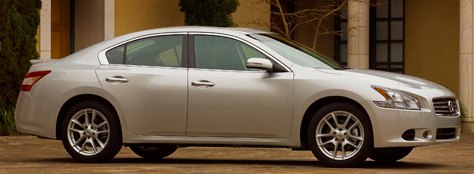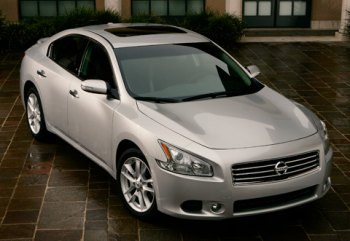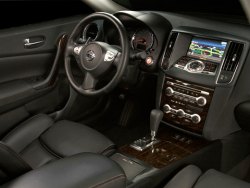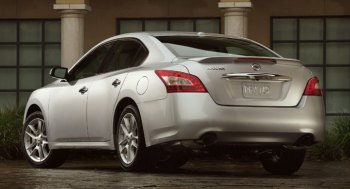|

|
To differentiate it from Altima,
Nissan makes it feel sportier as well as higher quality...
|
Offered
exclusively for
USA and Canada, Nissan Maxima has an embarrassing market positioning.
On the one hand Nissan wants to position it above the mainstream
Altima, on the other hand it
shall not steal sales from Infiniti G. Another problem is how close its
relationship with
Altima. They are built on the same platform using the same engine and
assembled in the same plant in Tennessee, USA. No wonder Maxima does
not depart very much from its cheaper sister in size, performance and
build quality. You can imagine how difficult for sales persons to
persuade customers
spending more money on the Maxima. Every year Nissan sells around
50,000 to 70,000 Maximas, a sharp contrast to the 250,000 units level
of Altima.
For the aforementioned reasons, in the making of new generation Maxima,
job number one was to differentiate it further apart
from Altima, making it feel sportier as well as higher quality in order
to
justify its price. Judging from looks alone, the mission seems
accomplished. Forget the fat and ugly old car, here comes a sports
sedan look-alike. It is wide, low and sleek, with sportscar fenders and
a handsome face. Let’s call it a gentleman in sportswear. It looks
handsomer than the current generation BMW 3-Series and Mercedes
C-class, although ultimately it lacks the attention to details of Audi
or the inspiration of Alfa Romeo. One thing is for sure: Nissan Maxima
has never been so stylish, so the first test has passed.

|
Judging from looks alone, the mission
seems accomplished... Let’s call it a gentleman in sportswear.
|
The second test goes to the cabin.
Sportiness is again the
main design theme. A simple instrument pod, wide transmission tunnel,
thick rim leather steering wheel, initiative
controls, steering column-mounted gearshift paddles and deep leather
bucket seats are what you would expect in a
German sports sedan. Ditto the soft-touch plastics over the dashboard.
Although other plastics at center console and door panels are less
convincing, the build quality is way above the level of previous
American-built Nissans. Most important, it feels more expensive than
Altima.
The cabin of new Maxima is slightly smaller than the old car, mainly
because its wheelbase has been shrunk by 50mm to 2775mm (the same as
Altima). Absolute cabin volume is now less than Altima, but 4 or even 5
six-footers will still find it a comfortable place.

|
In cabin, sportiness is again the main
design theme...
|
Nissan follows Mazda to downsize its
cars, but it does that to improve agility rather than economy. The new
Maxima is 75mm shorter and 12mm lower than the car it replaced yet it
has a wider stance and wider tracks
to benefit handling. Predictably, underneath the sheet metal is
Nissan's D-platform, the same one underpinning the current generation
Altima and Murano SUV. However, it differs from the mainstream model
by a stiffer chassis, more NVH insulation and some aluminum suspension
components that come from Infiniti M. The suspension tuning is
stiffer,
while sporty 245/40R19 tires are offered.
Engine is again that VQ35DE 3.5-liter DOHC with intake variable valve
timing, now tuned to 290 horsepower, 20 horses higher than Altima. That
is also more than what class rivals Honda Accord and Toyota Camry /
Avalon offer. The only transmission available is the Xtronic CVT -
again from Altima - but it is added with paddle shift to distinguish
from the cheaper model. In manual mode the CVT simulates a manual
gearbox with 6 fixed ratios. As we have found in Altima, this CVT is
matured enough to replace a conventional automatic gearbox, but keen
drivers will miss the direct response of a real manual box.
Strangely, despite of its stronger sporting pretension, Maxima is not
offered with a 6-speed manual box like Altima.

|
What Nissan claimed – “the best
front-wheel drive car in the world” – is far from the truth.
|
Anyway, with close to three hundred
horsepower under its
hood, performance will never disappoint. Car and Driver found it took
5.8 seconds to go from 0-60 mph, very good for a big family sedan. In
terms of handling, Maxima also feels more sporting than its Japanese
rivals, Honda Accord included. Stiff suspensions, wide tracks and
testing work done at Nurburgring Nordschleife (surprise !) result in
flat cornering and reasonably well suppression of torque steer.
However, what Nissan claimed – “the best front-wheel drive car in the
world” – is far from the truth. On twisty back roads, the Maxima feels
quite huge
and heavy to handle. Tight body control aside, it doesn't show the
balance and throttle adjustability we expected for a driver's car. It
also suffers from a harsh
ride on poor surfaces, blame to that stiff suspension setup. The
speed-sensitive steering is not the best among front-drive cars either,
being overlight at low speed and lacks feel all the time. All these
shortcomings mean it is not as much fun to drive as the best European
front-drive family sedans (and don't forget Mazda 6 of course), let
alone the rear-drive Australian cars, Chrysler 300 or BMW 3-Series.
To be a real
driver’s car, Maxima will probably need to lose some weight, conduct
more testing on back roads and employ a more sophisticated front
suspension than the MacPherson struts. But then how to build it on the
low-cost Altima platform ? The conflict between costs and engineering
excellence is always a headache to automotive engineers. As long as the
Maxima is built in Tennessee alongside Altima, I don’t see any
solutions.
|